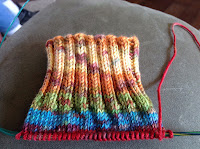I love wrapping presents. There are so many beautiful papers. But I also love beautiful fabric, especially the Christmas prints. So this year I decided, why not make reusable Christmas wrap?
My family has gotten to the point where they prefer gift cards. While that is easy for me to get them exactly what they want, I find it a bit boring. So to make it a bit more interesting for me, I have tried to come up with a different packages for housing gift cards. A crocheted snowman surrounded a gift card several years ago. But mostly simple little boxes, wrapped with pretty paper with ribbons and bows.

 This year I decided to make an origami triangular box. I made it from simple cotton fabric printed with poinsettias. I found the pattern on the Shabby Fabrics YouTube channel. The instructions were easy to follow and the pattern worked out perfectly. Although it was a bit large for two gift cards, I took up the extra space with some sweet candies and chocolates.
This year I decided to make an origami triangular box. I made it from simple cotton fabric printed with poinsettias. I found the pattern on the Shabby Fabrics YouTube channel. The instructions were easy to follow and the pattern worked out perfectly. Although it was a bit large for two gift cards, I took up the extra space with some sweet candies and chocolates. A lined drawstring bag works perfectly for those odd shaped items, or items without a box. My niece asked for clothes for her two little girls. Another niece asked for only money for her one-year-old and her savings account. I chose some snowman printed cotton fabric to make drawstring bags for each child. They went together quickly and easily and turned out pretty cute. Another bag made larger from a winter print, wrapped a shirt for the brother in law. Smaller ones fit DVDs. The possibilities are endless.
Then the question was, how do I label the bag? Standard paper sticky tags do not work very well on fabric. Taking some scrap fabric and Wonder-Under Fusible Web, I fused two scraps wrong sides together. Cutting a mailing label smaller than the decorative traditional label, I added some extra fabric glue and attached it to the fabric scrap. This paper will help hold traditional label better. I then cut circles for the bags and a triangle for the origami box. Using a hole punch, I made a hole in the top and attached a length of red ribbon. This year's label can be removed or a new label placed on top for the next recipient.
May God bless you and your during this holiday season and throughout the new year!!












